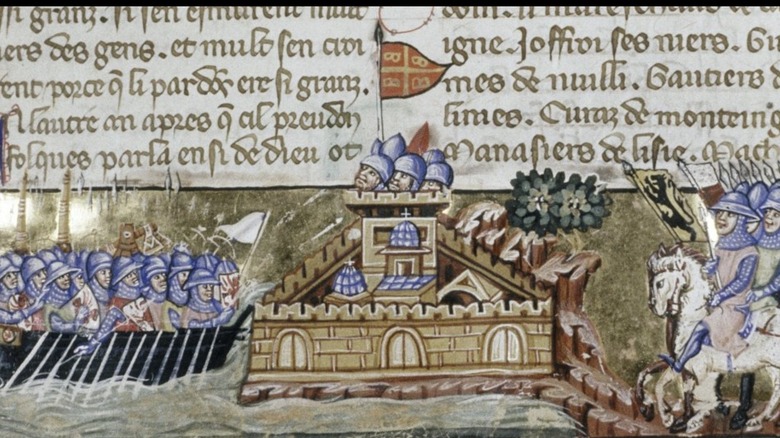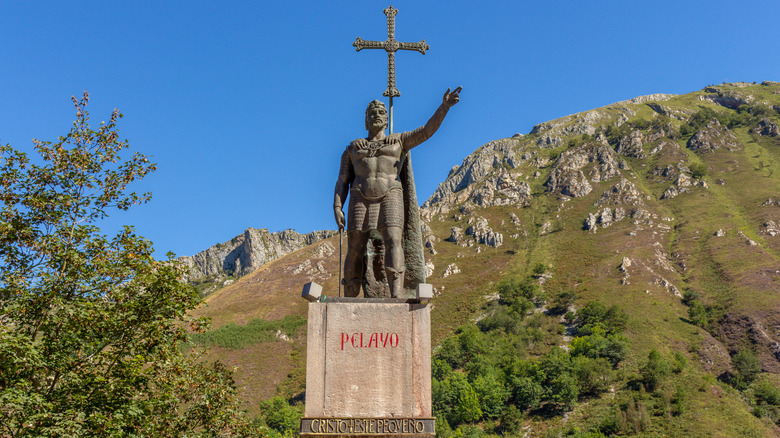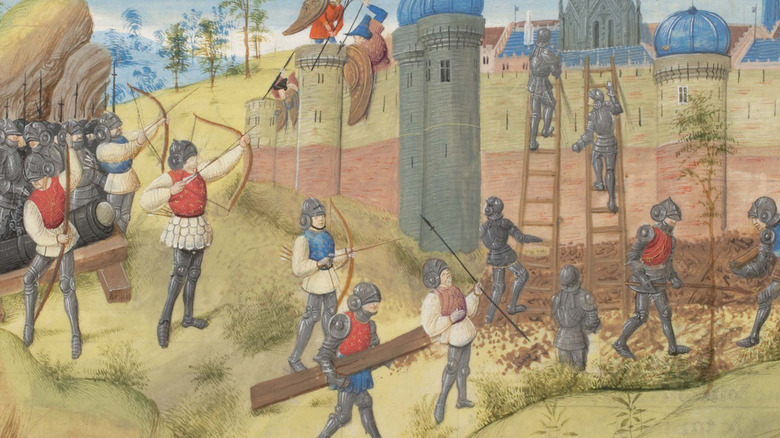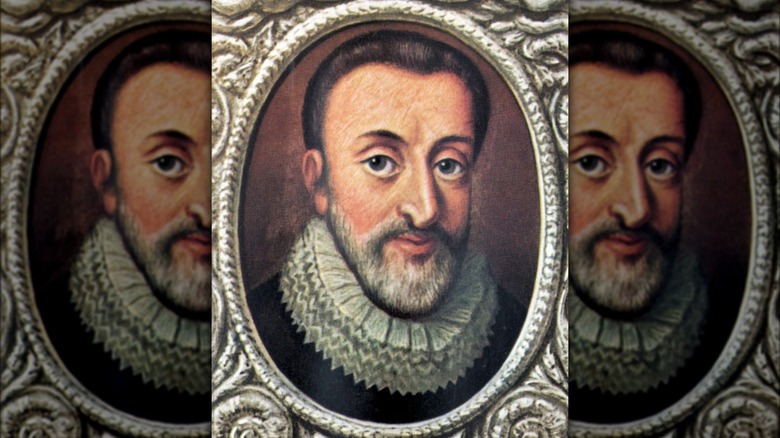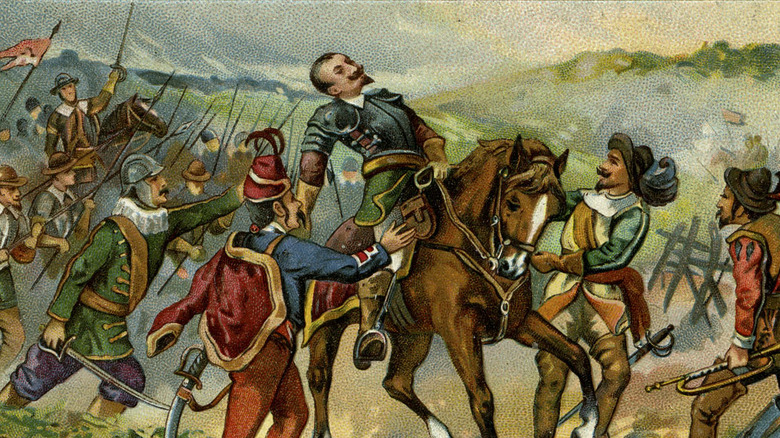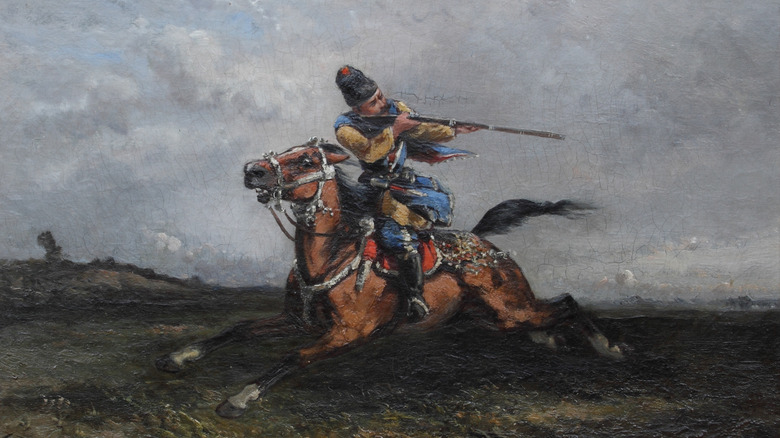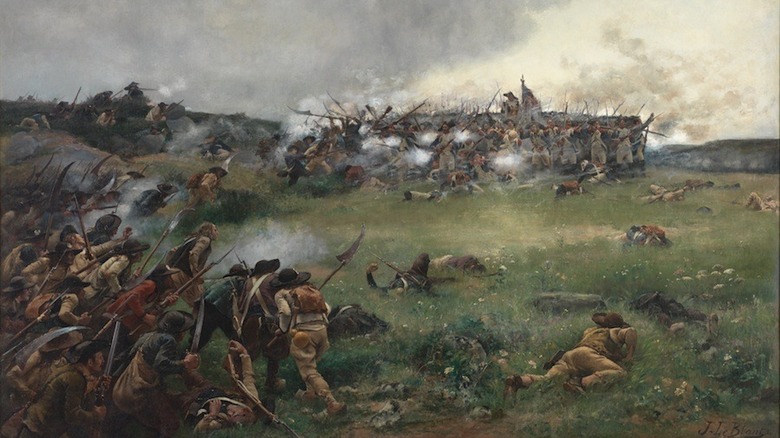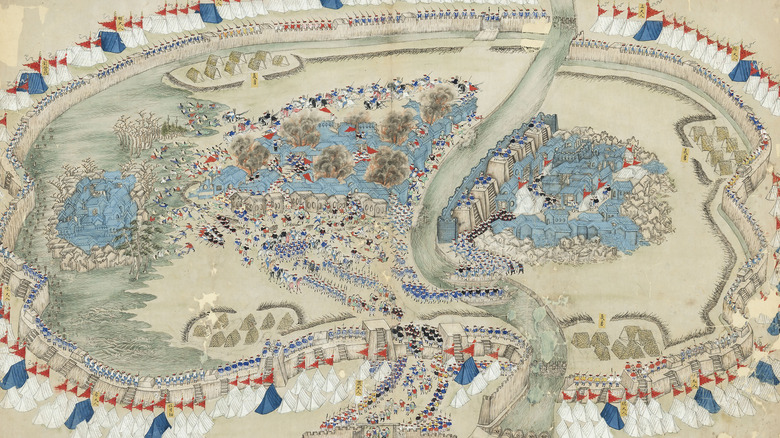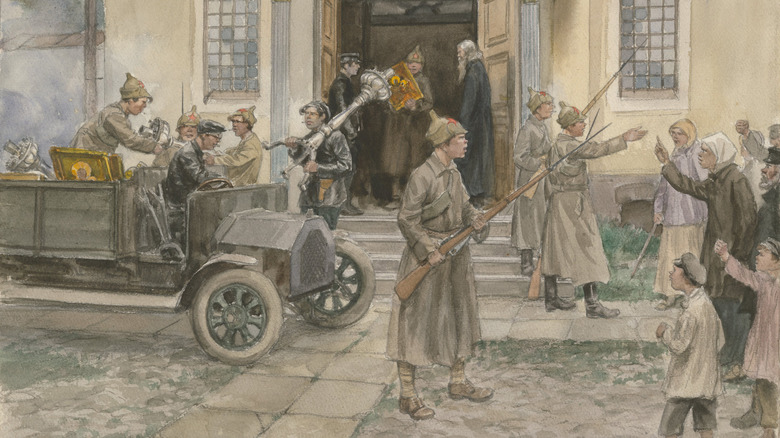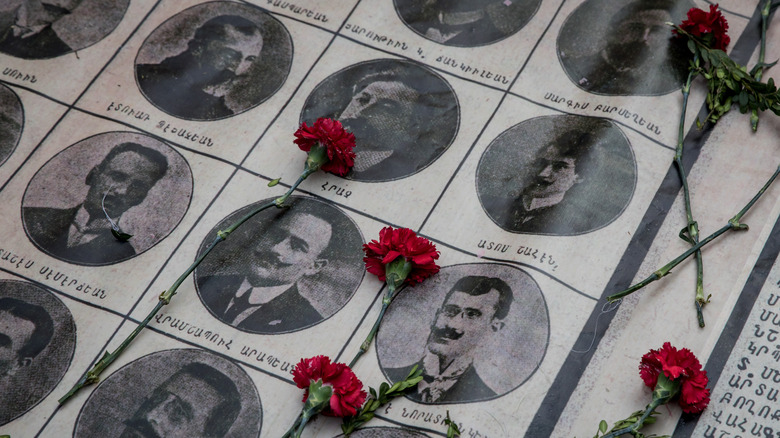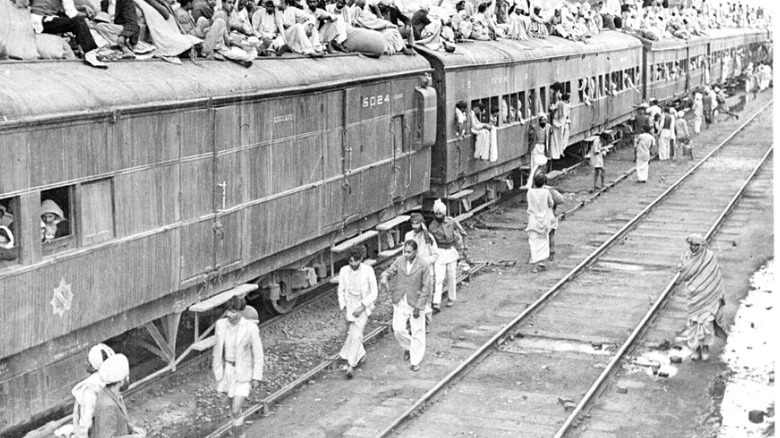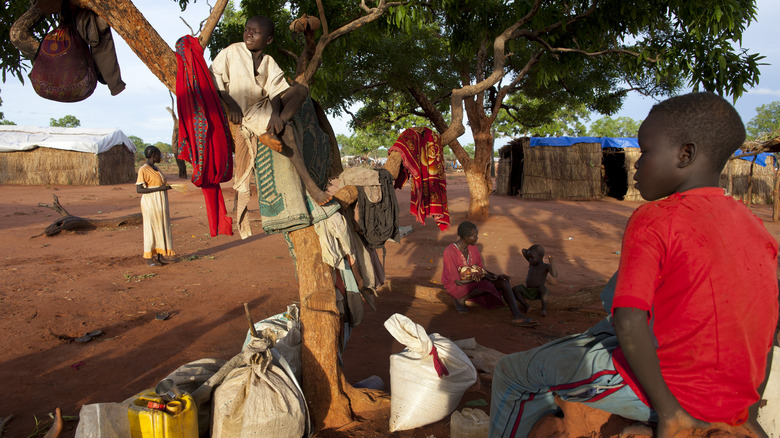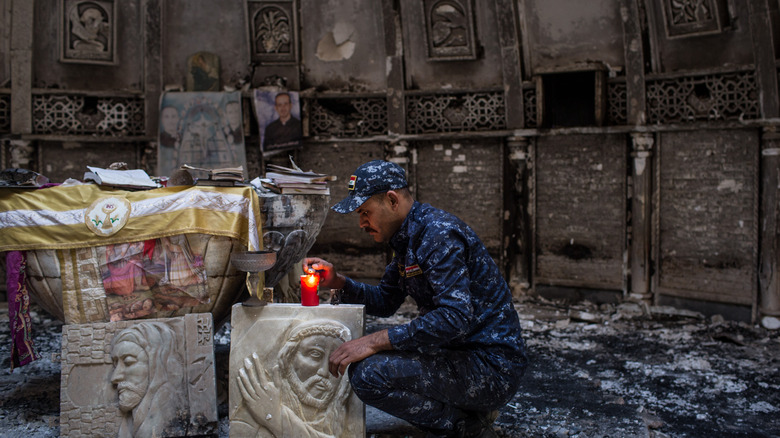The Deadliest Religious Conflicts In History Explained
Religious conflict is a defining feature of today's world, and it has been for millennia. Often, religion is just one factor in conflicts that result from a myriad of causes. But because of the emotional nature of religion, it often leads formerly peaceful neighbors to commit heinous acts against each other in the name of a higher power.
The worst religious conflicts of the past 2000 years have killed millions of people, but numbers do not tell the full story. Some of the deadliest religious conflicts have witnessed smaller numbers of dead and displaced but with fatal demographic, cultural, and human repercussions for their victims, often members of ethnic and religious minorities. Furthermore, the list of deadliest religious conflicts should not be viewed solely through absolute numbers of deaths and cultural and demographic damage. Survivors of recent conflicts carry invisible scars for the rest of their lives, and their stories are the best testimony to the horrors of religious conflict.
Here are some of history's deadliest religious conflicts.
The Reconquista
The term "Reconquista" refers to a series of wars beginning with the victory of Don Pelayo of Asturias at Covadonga around A.D. 720, as per Britannica. It pitted medieval Iberia's Muslim and Christian states. Although often framed as a one-dimensional religious conflict, the reality was a tangled web of alliances and intrigue that, according to Britannica, even saw Christian Alfonso VI of Castille take a Muslim concubine and extend toleration to his Muslim subjects. Thus, religion often came second to political expediency. This "conflict" is credited with some 7 million deaths (via National Interest).
As the Christian kingdoms grew stronger, religious lines hardened, leading to the key clash in 1212 at Las Navas de Tolosa. According to bishop and chronicler Lucas de Tuy (via IMS-Leeds), the Muslim forces sacked the town of Salvatierra after the Kingdom of Castile refused to surrender it and prepared to push north. In response, Pope Innocent III declared a crusade, urging Europe's Christians to Iberia's defense. The combined Christian forces subsequently crushed the Almohads and pacified most of southern Spain by 1250.
According Muslim chronicler Ali al-Tamimi al-Marrukshi, the Christian response to their new Muslim subjects varied. King Alfonso VII of Castile, the crusade leader, forbade the killing of Muslims that had surrendered, leading many crusaders to quit. But he also burned the mosque of Baeza and massacred the men of Ubeda. The women and children were taken prisoner. Thus Alfonso followed the long tradition among Christians and Muslims of showing mercy or force wherever it was convenient.
The First Crusade
According to "The Eastern Mediterranean Frontier of Latin Christendom," by Jace Stuckey, during the 11th century, the Seljuk Turks reserved particularly harsh treatment for Christian pilgrims visiting Jerusalem, who were subject to harassment, high taxes and tolls, and even death. After being approached by Emperor Alexios I to help with the crisis, as per historian Jonathan Harris, Pope Urban II declared a crusade in 1095 (via Boston University) to expel the Seljuks from the Holy Land, and Europe enthusiastically responded to the call.
The crusader army captured Jerusalem in 1099, as per Aljazeera, and massacred the population so ruthlessly that even Christian chroniclers questioned its necessity. The massacre is often considered the epitome of Christian intolerance, but as usual there were more expedient concerns than religion. According to historian Allen Murray (via Medievalists), the crusader massacre eliminated potential opposition should their Muslim opponents stir the populace to rebellion. That of course does not rule out religious motivations on the part of individual soldiers. According to History Extra, it is impossible to accurately estimate deaths from the First Crusade with extant source material, but between war, disease, and starvation, they were probably more than a few.
The French Wars of Religion
The French Wars of Religion raged across France in the 16th century, splitting the country between Catholic and Huguenot Protestant factions. According to Le Musee Protestant, Duke Francois de Guise massacred a group of France's Protestant minority in 1562. His Protestant rival Louis de Bourbon mustered an army and ignited the first war of eight. According to France's SciencesPo, the wars witnessed intercommunal violence, mob justice, and bloody repression of rebels on both sides, particularly the St. Bartholomew's Day Massacre of 1572.
The French Wars of Religion ended through a compromise. When the Protestant Henri III of Navarre became King Henri IV of France (pictured above), he decided that "Paris [was] well worth a Mass." Writing in the Catholic Historical Review, Edmund Dickerman noted that Henri agreed to convert to Catholicism in 1593 to stabilize his position. Although his motives were purely political, Dickerman noted that the Protestant king had major reservations. Nevertheless, he went through with it, but he did not forget his former Protestant brethren.
In 1598, Henri issued the Edict of Nantes. Although restrictive by today's standards, in the Renaissance, it was the gold standard of toleration. According to Le Musee Protestant, Protestants gained religious freedom, albeit with some restrictions. Although not perfect, it ended the 36-year bloodbath. European population statistics suggest that deaths were high. According to the Handbook of European History, France's population growth slowed considerably during the period of hostilities. The country had a population of 19 million in 1550, but only 20 million in 1600. In 1500, the population was 16.4 million.
The Thirty Years' War
This war began with the "defenestration of Prague," which, according to History, resulted in several Holy Roman dignitaries being thrown out a window in opposition to imperial Catholic attempts to encroach on Bohemian Protestantism. Soon, Europe was alight as virtually every major power and many smaller states involved themselves in a conflict that killed upwards of 8 million people.
The casualties from the Thirty Years War are down to two main causes. According to an article published in PLOS ONE, the Thirty Years' War coincided with Europe's "Little Ice Age," a time of lower temperatures and poor agricultural yields. Thus, the poor often joined the military to feed themselves. When their rations were insufficient, they robbed and killed civilians. War-induced food shortages led to starvation and disease, thus the massive civilian death tolls.
The second cause was battlefield deaths. Soldiers on the battlefield faced the prospect of a vicious death from gunpowder weapons or hand-to-hand combat. According to PLOS ONE, a sampling of 47 probably Swedish dead in a mass grave from the 1632 Battle of Lutzen showed that the dead had suffered horrific deaths from blunt force trauma or sharp-force trauma to the face, while several others had been shot in the face, probably at point-blank range while being trampled to death by imperial cavalry.
The Circassian War
Orthodox Russia's southward expansion towards the Black Sea in the 18th century brought it into direct conflict with the Ottoman Empire and the Islamic world. According to TRT, in a bid to gain control of the Black Sea coast, Russia decided to conquer the Ottoman-linked Muslim peoples of the North Caucasus. Little did they expect the fierce resistance from the Circassian Adyghe, Abkhaz, and Ubykh mountaineers. According to Stephen Shenfield (via Circassian World), the Muslim Caucasian mountaineers fought off the Russians for a whole century, between 1763 and 1864. Unable to conquer these proud and independent people, the Russian government decided to simply remove them.
Russian forces initially burned Caucasian villages and killed or deported their inhabitants into Russian territory. But when that strategy failed, St. Petersburg opted to evict them all and replace them with Russian colonists. So in 1864, almost 3 million Muslim Adyghe, Ubykhs, and Abkhaz (about 90% of ethnic population) were cruelly expelled from their homelands to the Ottoman Empire, which sent ships to ferry them across the Black Sea. Tragically, many of these ships sank in the stormy weather, while those that did not were ravaged by disease. The expelled Caucasians today live throughout the Middle East, from Turkey to Iraq, Israel, and Jordan. Although they have been very successful in their new lands, Al-Jazeera notes that the Circassians have not forgotten their genocide, a charge that is leveled against the Russian government to this day.
The French Revolution
The French Revolution, as the Institute for World Politics notes, was virulently anti-Catholic. Among the goals of the Revolution was the complete dechristianization of France in favor of a civic religion based around reason and the masonic Supreme Being.
To that end, the revolutionary government enacted a series of laws. First was the Civil Constitution of the Clergy. All Catholic clergy had to swear loyalty to the state, which controlled all clerical appointments instead of the pope. Those who refused fell under the broad penalties of the 1793 Law of Suspects, which sentenced any suspected counterrevolutionaries (including clergy) to death. Meanwhile, Notre Dame was re-consecrated as a Temple of Reason. In the ultimate profanation, a group of scantily clad women danced around the main altar, singing hymns to the Goddess of Reason.
The situation in Paris outraged the deeply Catholic inhabitants of Northern France. According to Quilette Magazine, an army of nobles, peasants, and clergy came together in the Vendee region of Brittany to resist the revolution after Paris shut down non-conforming churches and attempted to conscript Vendeeans into its army. In the bloody conflict that followed, French forces massacred over 100,000 people, including systemic campaigns of mass assault and drownings targeting women, which the perpetrators openly celebrated. Thus according to the Los Angeles Times, Vendee is one of the few regions of France that consistently refuses to commemorate the French Revolution.
The Taiping Rebellion
This strange war resulted in part from the garbled 19th-century re-introduction of Christianity to China. According to Columbia University, the 14-year war against the Manchu imperial dynasty began in 1850 after a man named Hong Xiuquan failed his civil service examination for the third time. So he raised an army to overthrow the Manchus and establish the Heavenly Kingdom of Great Harmony (Taiping Tianguo, hence the name). The rebellion, which found support from China's disenfranchised peasantry, seized over one-third of the country before it was finally defeated.
While the causes of the rebellion were mostly political, there was an interesting religious dimension. According to the BBC, between failing his exams and starting the war, Hong had read the New Testament. He claimed to have seen God whipping Chinese philosopher Confucius, the man credited with the Chinese civil service examinations that had ended Hong's career in the Chinese bureaucracy.
This is where things got truly bizarre. Hong declared himself Jesus Christ's younger brother, who had come to earth to eradicate the Confucian demons. According to Hong, the demons were none other than the foreign Manchu imperial family and its loyalists. Although the rebels scored some spectacular victories, their luck ran out by 1864. It is said that before his final defeat, Hong ensconced himself in a palace with his concubines while an organist played Christian hymns for them. By the end of the war, 20 million were dead, including Hong himself, whose body was discovered rotting in his palace.
The Bolshevik Revolution
The Bolshevik Revolution pitted committed atheists against their tsarist rivals. But there was a religious dimension to this famous conflict. The 1917 tumult saw the birth of state-sponsored militant atheism, which behaved like a militant religion that ruthlessly eliminated its opposition, especially the Russian Orthodox Church. According to Religion and Politics, the Soviet Union never banned religion outright. Instead, the USSR targeted religious communities based on their connections to the tsarist regime or their perceived compatibility with the communist worldview. This chiefly placed Christianity, especially Russian Orthodoxy, in the Bolsheviks' sights. Societies such as the League of the Militant Godless waged propaganda wars to turn citizens away from religion, and atheism was officially taught in schools.
After the initial bloodletting, the USSR realized that instead of destroying churches, it could transform them into monuments of atheism's triumph. According to DW, the Soviets converted churches into warehouses, movie theaters, and even swimming pools. Kazan's cathedral, per Russia Beyond, became the Museum of the History of Religion and Atheism. The Soviets had effectively made atheism into a state religion, with horrific results. Historians (via Heritage) note that as many as 30 million innocents perished in the Bolshevik Great Terror.
The Ottoman Christian genocide
The Armenian Genocide, which saw the Ottoman Empire massacre or exile its Armenian population, is well-known in Western circles. Less known is that it formed part of a greater Ottoman war on Christians. In fact, according to Haaretz, the Ottomans waged a Christian genocide against Turkey's millennia-old Christian communities, who were slated for elimination between 1914 and 1923.
The genocide, which occurred against the backdrop of World War I, began with massacres of the ancient Assyrian Christian communities. Assyrian historian Avraham Yohannan wrote that Turkish and Kurdish paramilitaries began rounding up Assyrians as early as 1914, accusing them of collaboration with Russian forces in the Caucasus. Survivors faced grueling marches to safety in Russian territory or concentration camps. The Armenian Genocide followed in 1915, and any resistance, according to the Armenian National Institute (ANI), was put down with heavy–handed force.
By 1918, over 600,000 Assyrians and 1.5 million Armenians were dead (via European Syriac Union). Survivors fled to neighboring states, Europe, and the Americas. But the tragedy for Christians did not end there. In 1923, the newly born Turkish Republic still had a large population of Greek Christians in its western territories, while Greece had a population of unwanted Muslims. Under the Treaty of Lausanne, both countries agreed to expel their respective unwanted populations. The resulting exchange, according to MERIP, transferred 1.5 million Greeks, who had inhabited Turkey for millennia, to Greece, while 500,000 Balkan Muslims were forcibly relocated to Turkey.
The Partition of India
According to Stanford University historian Priya Satia, the 1947 Partition of British India into the modern states of India and Pakistan triggered conflict and the "largest mass migration in human history." Now, nowhere did the partition agreement mandate a population exchange along religious lines. In fact, according to the Washington Times, many Indian Muslims initially opposed the partition and emigration. But circumstances turned what was supposed to be a peaceful split to quell sectarian tensions into a conflict that killed 2 million and displaced at least 15 million more.
According to Satia, the violence came primarily as the result of a rushed process. The British Army withdrew, leaving battle-hardened but divided Indian troops and partisan local law enforcement authorities to quell the simmering tensions. In a climate of uncertainty and fear, the hotter heads prevailed, and the tension escalated into open rioting, intimidation, and massacres between competing Hindu, Muslim, and Sikh groups.
Since the partition is still within living memory, there are numerous witnesses that recalled the horrific violence. Baljit Dhillon Vikram Singh, for instance, remembered grisly scenes of butchered bodies in the street as her family fled Lahore amid Muslim violence directed toward her fellow Sikhs. In another powerful testimony, Muslim Muhammad Yousuf described seeing a mob cut down a group of refugees in cold blood and "corpses piled as high as houses" with no one to pray for them or even give them a respectable burial. There are many more powerful testimonies to which it is difficult to do justice. The Partition and religious cleansing continues to stoke tension between India and Pakistan today.
The Second Sudanese Civil War
In 2011, according to the Department of State's Historian's Office, President Barack Obama welcomed South Sudan to the family of nations. This new nation was truly forged in war, blood, and religious conflict, which pitted the Christian and animist South Sudan against the mainly Muslim north governed from Khartoum.
Writing in the "Middle East Quarterly” in 2001 (via ME Forum), political scientist Francis Deng noted that after its 1956 independence, Sudan embarked on a program of Arabization and Islamization among the southern tribes, who used English for inter-ethnic communication and adhered either to Christianity or Indigenous beliefs. Using Arab militias, the Sudanese government targeted the Dinka people of South Sudan, burning villages, destroying crops, and displacing civilians. With war and devastation came famine and disease. According to Tufts University, the Sudanese government even turned its genocidal policies against fellow Muslims in the Nuba Mountains. President Omar al-Bashir and Sudan's religious authorities declared them apostates for their retention of pre-Islamic practices, bombing and burning their villages and herding ethnic Nuba into "peace camps" (aka concentration camps) for forcible resettlement.
Together, the Nuba and South Sudanese forces managed to suck the Sudanese army into a vicious war of attrition that the government was unable to win by 2005. But the human cost was enormous. At least 2 million perished, and hundreds of thousands (at least) were displaced. As Tufts notes, the majority, tragically, were innocent civilians, who died of starvation and the deprivations of war.
The Syrian Civil War
The Syrian Civil War, which according to the BBC, has claimed between 350,000 to 600,000 lives, began in 2011 on the back of the Arab Spring protests that swept the Middle East in 2010. According to NPR, the conflict quickly turned religious as the core Syrian president Bashar Assad's opposition turned out to be composed of Islamists. Among them was the Islamic State in Iraq and Syria (ISIS), whose brutality against religious minorities shocked the world.
As the Syrian Civil War spread to neighboring Iraq, already racked with instability following the 2003 American invasion, ISIS began targeting minority groups, particularly Yazidis and Assyrian Christians. According to the University of Minnesota, Christians were ordered to pay protection money, leave, or die. Women and children became slaves to ISIS fighters, while Shia Muslim Turkmen were killed as heretics.
Although Syria has stabilized, the human toll has been staggering. According to the 114th Congress, of the 45,000 Christians living in Mosul in 2004, for instance, only a few hundred remain. According to the Yazidi charity, "Nadia's Initiative," founded by survivor Nadia Murad, 400,000 Yazidis were displaced, 5,000 killed, and 6,000 enslaved.
